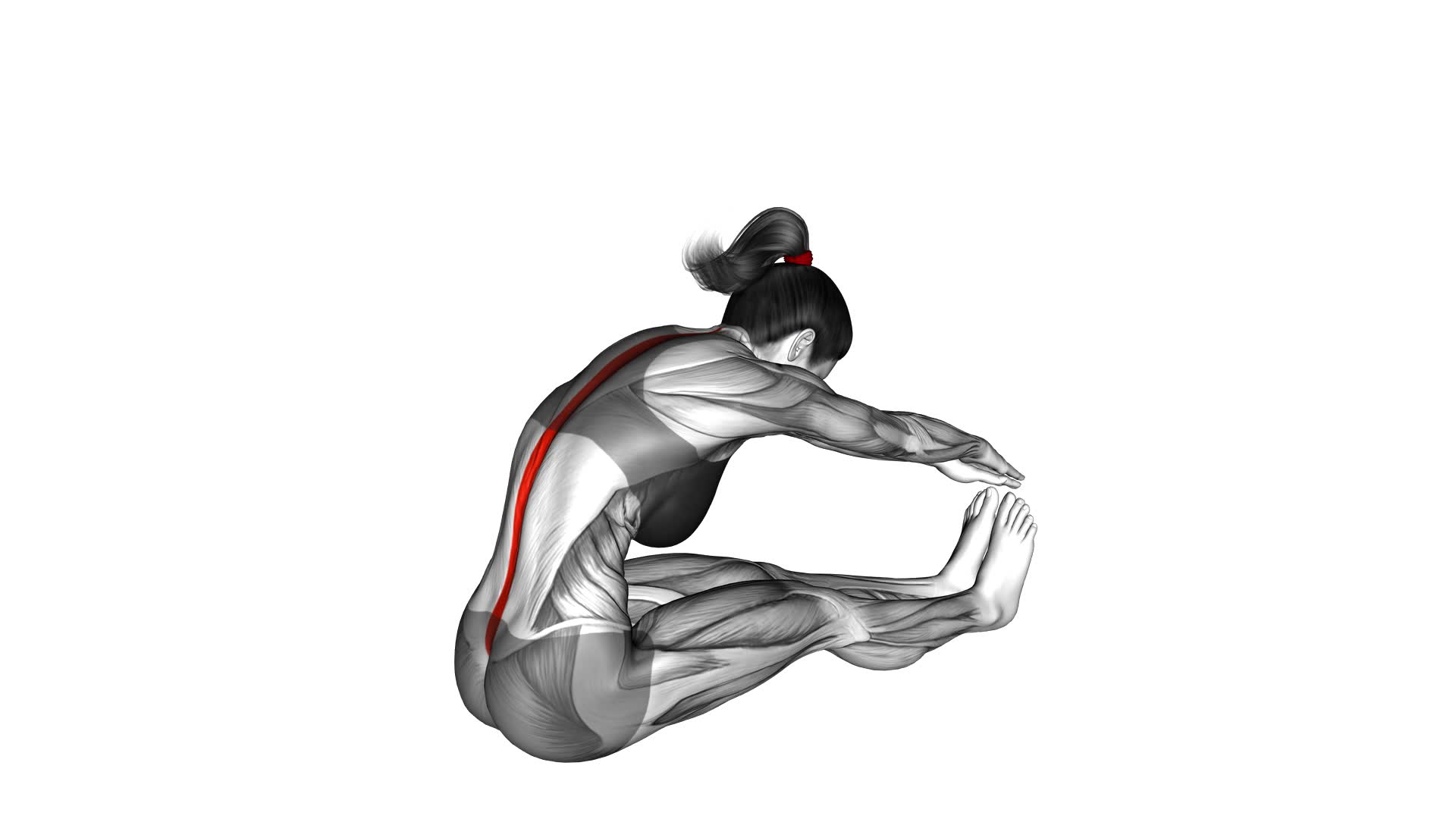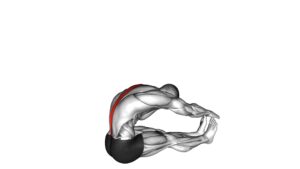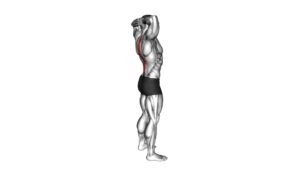Spine Stretch (female) – Video Exercise Guide & Tips

Are you looking to improve your flexibility and strengthen your back? Look no further than the spine stretch exercise.
Watch This Exercise Video
In this video exercise guide, you'll find all the tips and techniques you need to master this move. Whether you're a beginner or advanced, there are modifications and progressions for everyone.
Avoid common mistakes and get the most out of your workout routine by incorporating the spine stretch.
Get ready to stretch and strengthen your spine like never before.
Key Takeaways
- Improved flexibility
- Alleviating back pain
- Enhancing core strength
- Proper form and technique
Benefits of the Spine Stretch Exercise
You will experience numerous benefits by incorporating the Spine Stretch Exercise into your fitness routine. This exercise focuses on stretching and lengthening the muscles of your spine, providing a range of advantages for your overall health and well-being.
One of the benefits of the Spine Stretch Exercise is improved flexibility. By performing different variations of this exercise, such as the seated or standing version, you can target different areas of your spine and increase your overall flexibility. This can help enhance your range of motion and prevent injuries.
Additionally, the Spine Stretch Exercise can help alleviate back pain. By stretching the muscles and ligaments surrounding your spine, you can relieve tension and reduce discomfort in your lower back. This exercise can also help improve your posture by strengthening the muscles that support your spine, leading to better alignment and reduced strain on your back.
Moreover, incorporating the Spine Stretch Exercise into your fitness routine can enhance your core strength. This exercise engages the muscles of your core, including your abdominals and obliques, which can lead to a stronger and more stable core. A strong core is essential for maintaining proper posture and supporting your spine during everyday activities.
Proper Form and Technique for the Spine Stretch
To perform the Spine Stretch exercise with proper form and technique, there are a few key points to keep in mind.
First, focus on maintaining proper alignment and posture throughout the movement, keeping your spine lengthened and your shoulders relaxed.
Secondly, engage your core muscles by drawing your navel towards your spine, which will help you stabilize and support your back.
Alignment and Posture
Maintain proper alignment and posture throughout the Spine Stretch exercise to ensure effective engagement of the core muscles.
Proper alignment and posture are essential for maximizing the benefits of this exercise, including improved flexibility and potential back pain relief.
Here are some key tips to help you maintain proper alignment and posture:
- Sit tall with your spine lengthened and your shoulders relaxed.
- Engage your core muscles by drawing your navel towards your spine.
- Keep your neck and shoulders relaxed, avoiding any tension or strain.
By maintaining proper alignment and posture, you can optimize the effectiveness of the Spine Stretch exercise and reduce the risk of injury.
Remember to listen to your body and make any necessary adjustments to ensure you're performing the exercise correctly.
Core Engagement Tips
Sitting tall with a lengthened spine and relaxed shoulders, engage your core muscles by drawing your navel towards your spine for proper form and technique during the Spine Stretch exercise.
Core engagement is crucial in this exercise as it helps to stabilize your body and protect your spine. By activating your core, you're strengthening the deep muscles of your abdomen, back, and pelvis, which play a vital role in maintaining good posture and preventing injuries.
To achieve proper core activation, focus on pulling your belly button in towards your spine, while maintaining a gentle contraction in your abdominal muscles. This will create a strong foundation for the exercise, allowing you to move with control and stability.
Now that you have engaged your core, let's move on to the next section about breathing techniques.
Breathing Techniques
As you engage your core muscles in the Spine Stretch exercise, it's important to focus on your breathing technique for proper form and technique. Proper breath control helps to enhance your overall performance and maximize the benefits of this exercise.
Here are some relaxation techniques to incorporate into your Spine Stretch routine:
- Deep Breaths: Take slow, deep breaths in and out during the exercise. This helps to oxygenate your muscles and promote relaxation.
- Exhale on the Stretch: As you stretch forward, exhale deeply to release tension and deepen the stretch.
- Inhale on the Return: When returning to the starting position, inhale slowly to prepare your body for the next repetition.
Modifications and Progressions for All Fitness Levels
To cater to individuals of all fitness levels, you can modify and progress the Spine Stretch exercise.
Modifications allow beginners or those with limited flexibility to perform the exercise with ease, while progressions challenge those who are more advanced.
If you're a beginner, you can start by sitting on a folded towel or cushion to elevate your hips and make it easier to lengthen your spine. You can also bend your knees slightly to reduce the strain on your lower back.
As you become more comfortable with the exercise, you can gradually straighten your legs and lower your hips to the mat.
For those who are looking for a challenge, there are several progressions you can try.
One option is to hold a small weight or medicine ball in your hands while performing the exercise. This adds resistance and further engages your core muscles.
Another progression is to increase the range of motion by reaching your hands farther forward or bringing your chest closer to your thighs. You can also experiment with different arm positions, such as extending your arms overhead or out to the sides, to target different muscle groups.
Remember to always listen to your body and make modifications or progressions that are appropriate for your fitness level. It's important to gradually build strength and flexibility over time to prevent injury.
Common Mistakes to Avoid During the Spine Stretch
To improve your posture while stretching, remember to:
- Keep your spine straight and avoid slouching.
- Maintain proper breathing technique by inhaling deeply through your nose and exhaling fully through your mouth.
- Engage your core muscles correctly by pulling your belly button in towards your spine.
Improve Posture While Stretching
Maintain proper alignment and avoid these common mistakes to improve your posture while stretching during the Spine Stretch exercise.
- Engage your core: Keep your abdominal muscles tight throughout the exercise to support your spine and maintain good posture.
- Lengthen your spine: Imagine a string pulling the top of your head towards the ceiling, elongating your spine and avoiding slouching.
- Avoid rounding your back: Keep your back straight and avoid hunching forward during the stretch to prevent strain on your back muscles.
Improving your posture while stretching is essential for both improving flexibility and preventing back pain.
By maintaining proper alignment and avoiding common mistakes, you can ensure that you're getting the most out of the Spine Stretch exercise while keeping your back safe and healthy.
Remember to engage your core, lengthen your spine, and avoid rounding your back to achieve optimal posture during the stretch.
Proper Breathing Technique
Engage your breath properly to enhance the effectiveness of the Spine Stretch exercise and avoid these common mistakes.
Proper breathing technique is essential for maximizing the benefits of any exercise, including the Spine Stretch.
One common mistake is holding your breath during the exercise. Remember to inhale deeply through your nose and exhale fully through your mouth. This not only helps to improve focus, but also aids in relaxation and allows for better oxygenation of the muscles.
Another mistake to avoid is shallow breathing. Take deep breaths, filling your lungs completely, and exhale fully to release any tension in your body.
Engage Core Muscles Correctly
Are you properly activating your core muscles during the Spine Stretch exercise? Engaging your core correctly is crucial for getting the most out of this exercise and preventing injury.
Here are some common mistakes to avoid and tips to ensure proper core activation:
- Keep your abdominal muscles pulled in and engaged throughout the exercise.
- Avoid allowing your lower back to arch or your shoulders to hunch forward.
- Focus on maintaining a neutral spine position, with your core muscles supporting your posture.
By actively engaging your core, you won't only strengthen your abdominal muscles but also improve your stability and overall posture. Remember to breathe deeply and smoothly as you perform the Spine Stretch, allowing your core to work efficiently.
Practice proper core activation to maximize the benefits of this exercise and avoid unnecessary strain on your body.
Tips for Incorporating the Spine Stretch Into Your Workout Routine
To enhance your workout routine, try incorporating the spine stretch exercise. This exercise not only helps to improve flexibility and mobility in your spine, but also engages your core muscles.
To ensure proper alignment and breathing during the exercise, start by sitting up tall with your legs extended in front of you and your feet flexed. Keep your spine lengthened and your shoulders relaxed. As you exhale, imagine pulling your naval towards your spine to engage your core. Inhale deeply, filling your lungs with air, and as you exhale, gently round your spine forward, reaching your arms towards your feet. Remember to keep your neck relaxed and your shoulders away from your ears.
Modifications and progressions can be made to adapt the spine stretch exercise to your fitness level. If you're a beginner, you can start by bending your knees slightly or using a prop, such as a yoga block, to sit on. This will help to decrease the intensity of the stretch.
As you become more advanced, you can try straightening your legs more or reaching your arms further towards your feet. Remember to listen to your body and only go as far as feels comfortable for you.
Incorporating the spine stretch exercise into your workout routine can help to improve your posture, increase flexibility in your spine, and strengthen your core muscles. Give it a try and feel the benefits for yourself!
Precautions and Contraindications for the Spine Stretch Exercise
When performing the spine stretch exercise, it's important to be aware of precautions and contraindications to ensure a safe and effective workout. Here are some key points to keep in mind:
- Consult with your healthcare provider: If you have any pre-existing medical conditions or injuries, it's crucial to consult with your healthcare provider before attempting the spine stretch exercise. They'll be able to assess whether it's suitable for you and provide any necessary modifications or alternatives.
- Maintain proper form: It's essential to maintain proper form throughout the exercise to avoid any strain or injury. Make sure to engage your core, keep your spine aligned, and avoid excessive rounding or arching of the back.
- Listen to your body: Pay attention to any discomfort or pain during the spine stretch exercise. If you experience sharp or shooting pain, dizziness, or difficulty breathing, stop immediately and seek medical attention if needed.
Remember, everyone's body is different, and what works for one person may not work for another. It's important to approach the spine stretch exercise with caution and always prioritize your safety and well-being.
Frequently Asked Questions
How Many Repetitions of the Spine Stretch Exercise Should I Do?
To get the most out of the spine stretch exercise, it's important to consider your own fitness level and goals. Generally, experts recommend starting with 8-10 repetitions and gradually increasing as you become more comfortable.
This exercise can improve posture, flexibility, and core strength. Remember, there are different variations and modifications available to suit your needs.
It's always a good idea to consult with a fitness professional for personalized guidance.
Can the Spine Stretch Exercise Help With Posture Correction?
Yes, the spine stretch exercise can help with posture correction.
By engaging your core and stretching your spine, this exercise helps to strengthen the muscles that support good posture.
Regularly performing the spine stretch exercise can improve your alignment, reduce slouching, and increase overall body awareness.
The benefits of the spine stretch exercise go beyond just posture correction, as it also helps to relieve tension in the back and improve flexibility.
Is It Normal to Feel a Stretch in the Lower Back During the Spine Stretch Exercise?
Feeling a stretch in your lower back during the spine stretch exercise is normal. It indicates that you're engaging the muscles in your back and working on increasing flexibility.
However, it's important to maintain proper form to avoid any discomfort or injury. Make sure to keep your spine elongated and your core engaged throughout the exercise.
If you experience any pain, it's advisable to consult a fitness professional for guidance.
Can the Spine Stretch Exercise Help Alleviate Back Pain?
The spine stretch exercise can be a beneficial addition to your daily workout routine. It has the potential to help alleviate back pain by stretching and strengthening the muscles in your back.
To ensure proper form and technique, remember to sit tall with your legs straight, engage your core, and reach forward with a straight spine.
Incorporating this exercise into your routine can provide numerous benefits for your back health.
Can the Spine Stretch Exercise Be Done by People With Pre-Existing Back Injuries or Conditions?
The spine stretch exercise can be modified for individuals with pre-existing back injuries or conditions. If you have a back injury, it's important to consult with a healthcare professional before attempting this exercise. They can provide specific modifications or alternative exercises that are safe and appropriate for your condition.
Conclusion
Incorporating the spine stretch exercise into your workout routine can provide numerous benefits. These include improved flexibility, posture, and core strength. By maintaining proper form and technique, you can maximize the effectiveness of this exercise.
Remember to listen to your body and make modifications or progressions as needed to suit your fitness level. It's important to avoid common mistakes and be cautious if you have any pre-existing conditions.
With these tips in mind, you can safely and effectively incorporate the spine stretch into your fitness routine.

Author
Years ago, the spark of my life’s passion ignited in my mind the moment I stepped into the local gym for the first time. The inaugural bead of perspiration, the initial endeavor, the very first surge of endorphins, and a sense of pride that washed over me post-workout marked the beginning of my deep-seated interest in strength sports, fitness, and sports nutrition. This very curiosity blossomed rapidly into a profound fascination, propelling me to earn a Master’s degree in Physical Education from the Academy of Physical Education in Krakow, followed by a Sports Manager diploma from the Jagiellonian University. My journey of growth led me to gain more specialized qualifications, such as being a certified personal trainer with a focus on sports dietetics, a lifeguard, and an instructor for wellness and corrective gymnastics. Theoretical knowledge paired seamlessly with practical experience, reinforcing my belief that the transformation of individuals under my guidance was also a reflection of my personal growth. This belief holds true even today. Each day, I strive to push the boundaries and explore new realms. These realms gently elevate me to greater heights. The unique combination of passion for my field and the continuous quest for growth fuels my drive to break new ground.



